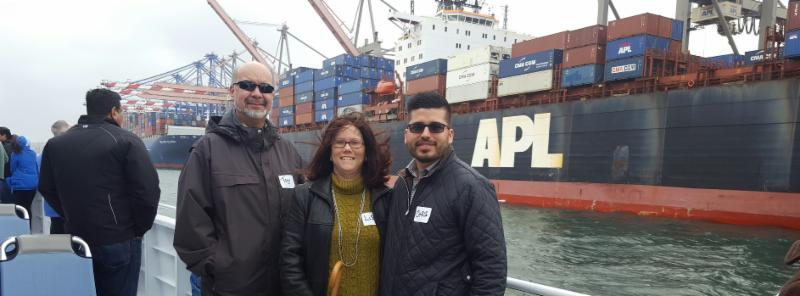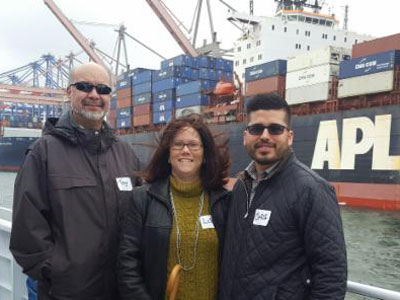
The global supply chain situation remains in a constant state of chaos. $1 billion of goods flows through the ports per day, and so there is a BIG ripple effect on the supply chain. Although there is a lot of talk and action by various groups to improve the situation, it continues to deteriorate. Backlogs create additional issues that spiral out of control with many parties involved in a complex “system of systems” (thanks to Fran Inman for this phrase).
Although an old photo from pre-COVID when I visited the port with my Association for Supply Chain Management group, I thought it appropriate 🙂

Highlights/ status of the global supply chain situation:
- Container ships continue to overflow at the Southern CA ports – the numbers continue to stack up of container ships waiting for berths (anchored, loitering within 40 miles or loitering or slow steaming further offshore)
- LA/ LB ports are landlord ports and not responsible for the movement or handling of cargo (different parties/ interests)
- The LA/ LB port terminals have different appointment systems – we wouldn’t this to be too easy!
- There is a labor shortage at the ports due to the people required to operate 24/7, impacts of COVID and the Great Resignation, and union-related nuances.
- Terminal operations are not automated (and therefore not as efficient/ fast) – with the exception of a pilot terminal. Unfortunately, there is union conflict with expansion of automation (and therefore throughput increases)
- Truckers are not paid to “wait” for the “right” product to be ready at the “right” terminal at the “right” time
- There is a shortage of chassis (with no quick recovery as they aren’t produced in the U.S.)
- There are piles of empty containers with nowhere to store them and conflict and chaos in trying to coordinate the return of these containers to Asia.
- There are vast complications with California goods movement regulations
- Warehouses are full and have labor shortages
- There are significant shortages in truck drivers, truck equipment etc.
- The rail yards are experiencing unprecedented train burglaries and delays due to thefts. Thefts have increased an eye popping 356% from October 2020 to October 2021.
- The “big guys” are taking matters into their own hands by renting out their own shipping containers, looking for different ports of entry, etc.
- And the list goes on……..
What Should We Consider and/or What Impacts Could Arise?
Start taking control of your end-to-end supply chain situation.
At a minimum, understand your current state, risks and opportunities, and start thinking about your manufacturing and supply chain strategy. Reevaluate your manufacturing operations, what you insource vs. outsource, what you offload to a regional cluster vs. source globally, which geographies you source from (and related logistics networks), where you manufacture, your backup options, your supplier base, your supply chain partners, your ability to scale, your technology capabilities and more.
Consider implementing a SIOP/ S&OP (sales, inventory and operations planning) process to get a better handle on your customers’ needs for the next 12-24 months so that you can determine the best way to supply it. SIOP will help determine the best way to provide a superior customer experience (on-time delivery, shorter lead-times, upgraded products and service options, etc.) while supporting growth, profitability and working capital objectives. This will lead back to your manufacturing and supply chain strategy discussions as well as your planning execution discussions.
Please keep us in the loop of your situation and how we can help your organization successfully navigate the current volatility and, more importantly, emerge above and beyond. Several of these types of topics are included in our new eBook Emerging Above and Beyond: 21 Insights for 2021 from Manufacturing, Supply Chain & Technology Executives. Download your complimentary copy and stay tuned for our 2022 special report.




